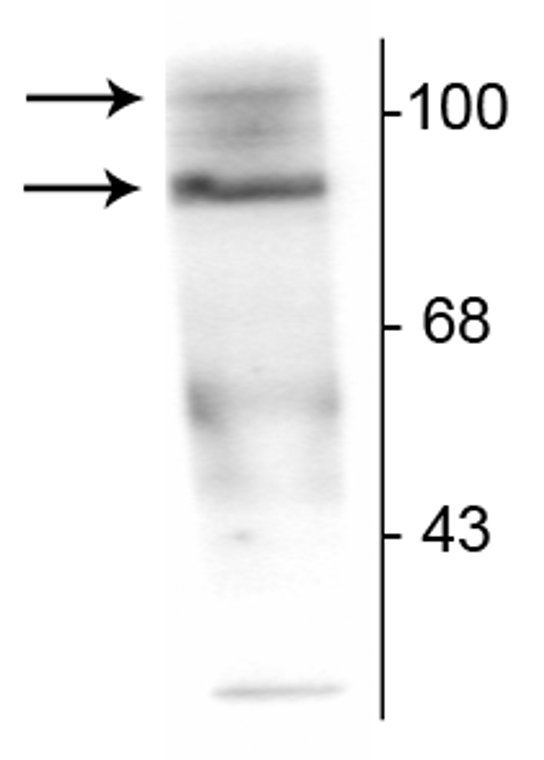| Host: |
Mouse |
| Applications: |
WB/IHC |
| Reactivity: |
Human |
| Note: |
STRICTLY FOR FURTHER SCIENTIFIC RESEARCH USE ONLY (RUO). MUST NOT TO BE USED IN DIAGNOSTIC OR THERAPEUTIC APPLICATIONS. |
| Short Description: |
Mouse monoclonal antibody anti-Phospho-Progesterone Receptor-Ser190 is suitable for use in Western Blot and Immunohistochemistry research applications. |
| Clonality: |
Monoclonal |
| Clone ID: |
1154 |
| Conjugation: |
Unconjugated |
| Isotype: |
IgG1 |
| Formulation: |
100 µl in 10 mM HEPES (pH 7.5) , 150 mM NaCl, 100 µg per ml BSA and 50% Glycerol. |
| Purification: |
This antibody was protein g purified culture from supernatant. |
| Dilution Range: |
WB 1:1000IHC 1:1000ICCIP |
| Storage Instruction: |
Store at-20°C for up to 1 year from the date of receipt, and avoid repeat freeze-thaw cycles. |
| Gene Symbol: |
PGR |
| Gene ID: |
5241 |
| Uniprot ID: |
PRGR_HUMAN |
| Immunogen: |
Synthetic phospho-peptide corresponding to amino acid residues surrounding Ser190 conjugated to KLH. |
| Tissue Specificity | In reproductive tissues the expression of isoform A and isoform B varies as a consequence of developmental and hormonal status. Isoform A and isoform B are expressed in comparable levels in uterine glandular epithelium during the proliferative phase of the menstrual cycle. Expression of isoform B but not of isoform A persists in the glands during mid-secretory phase. In the stroma, isoform A is the predominant form throughout the cycle. Heterogeneous isoform expression between the glands of the endometrium basalis and functionalis is implying region-specific responses to hormonal stimuli. |
| Post Translational Modifications | Phosphorylated on multiple serine sites. Several of these sites are hormone-dependent. Phosphorylation on Ser-294 occurs preferentially on isoform B, is highly hormone-dependent and modulates ubiquitination and sumoylation on Lys-388. Phosphorylation on Ser-102 and Ser-345 also requires induction by hormone. Basal phosphorylation on Ser-81, Ser-162, Ser-190 and Ser-400 is increased in response to progesterone and can be phosphorylated in vitro by the CDK2-A1 complex. Increased levels of phosphorylation on Ser-400 also in the presence of EGF, heregulin, IGF, PMA and FBS. Phosphorylation at this site by CDK2 is ligand-independent, and increases nuclear translocation and transcriptional activity. Phosphorylation at Ser-162 and Ser-294, but not at Ser-190, is impaired during the G(2)/M phase of the cell cycle. Phosphorylation on Ser-345 by ERK1/2 MAPK is required for interaction with SP1. Sumoylation is hormone-dependent and represses transcriptional activity. Sumoylation on all three sites is enhanced by PIAS3. Desumoylated by SENP1. Sumoylation on Lys-388, the main site of sumoylation, is repressed by ubiquitination on the same site, and modulated by phosphorylation at Ser-294. Ubiquitination is hormone-dependent and represses sumoylation on the same site. Promoted by MAPK-mediated phosphorylation on Ser-294. Palmitoylated by ZDHHC7 and ZDHHC21. Palmitoylation is required for plasma membrane targeting and for rapid intracellular signaling via ERK and AKT kinases and cAMP generation. |
| Function | The steroid hormones and their receptors are involved in the regulation of eukaryotic gene expression and affect cellular proliferation and differentiation in target tissues. Depending on the isoform, progesterone receptor functions as transcriptional activator or repressor. Isoform A: Ligand-dependent transdominant repressor of steroid hormone receptor transcriptional activity including repression of its isoform B, MR and ER. Transrepressional activity may involve recruitment of corepressor NCOR2. Isoform B: Transcriptional activator of several progesteron-dependent promoters in a variety of cell types. Involved in activation of SRC-dependent MAPK signaling on hormone stimulation. Isoform 4: Increases mitochondrial membrane potential and cellular respiration upon stimulation by progesterone. |
| Protein Name | Progesterone ReceptorPrNuclear Receptor Subfamily 3 Group C Member 3 |
| Database Links | Reactome: R-HSA-1251985Reactome: R-HSA-3371497Reactome: R-HSA-383280Reactome: R-HSA-4090294Reactome: R-HSA-9018519 |
| Cellular Localisation | NucleusCytoplasmNucleoplasmic Shuttling Is Both Hormone- And Cell Cycle-DependentOn Hormone StimulationRetained In The Cytoplasm In The G(1) And G(2)/M PhasesIsoform A: NucleusMainly NuclearIsoform 4: Mitochondrion Outer Membrane |
| Alternative Antibody Names | Anti-Progesterone Receptor antibodyAnti-Pr antibodyAnti-Nuclear Receptor Subfamily 3 Group C Member 3 antibodyAnti-PGR antibodyAnti-NR3C3 antibody |
Information sourced from Uniprot.org
12 months for antibodies. 6 months for ELISA Kits. Please see website T&Cs for further guidance






